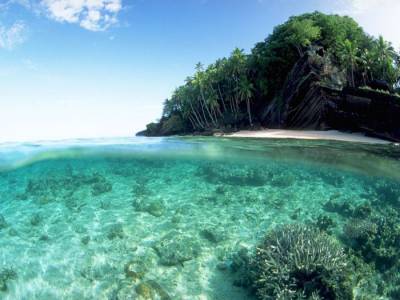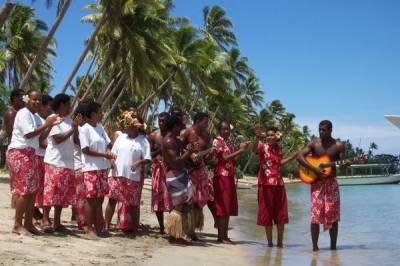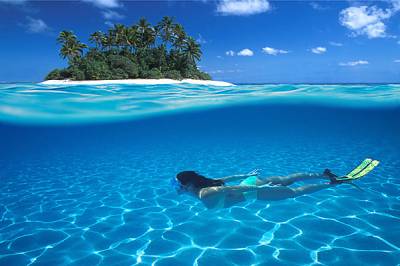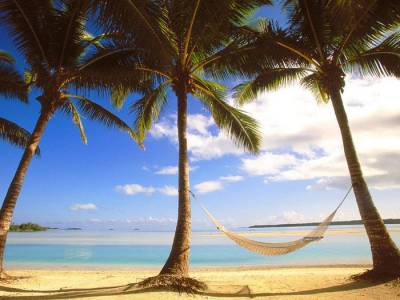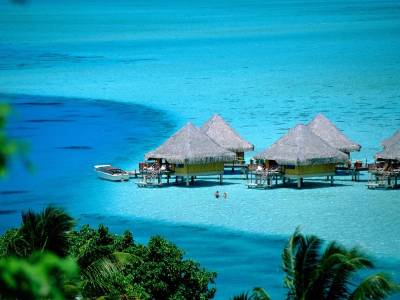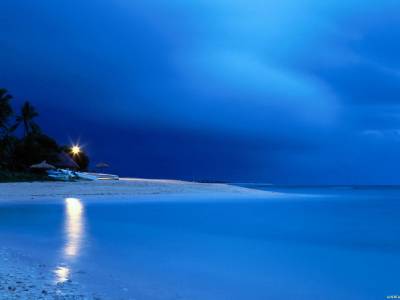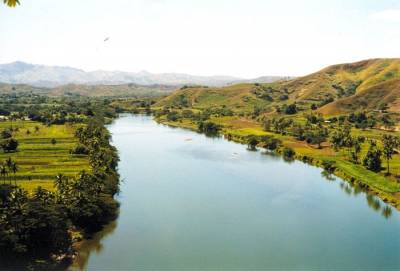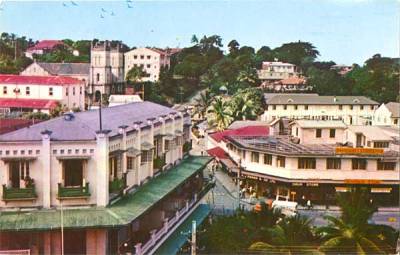FIJI
GEOGRAPHICAL POSITION
The state of Fiji is in a southeast part of the Pacific Ocean and is located on more than 300 islands which total area makes only 18 thousand sq.km. About 100 islands are manned, the others represent peculiar corners of the untouched nature. The largest islands - Viti Levu (10,4 thousand sq.km), on it lives about 70 % of the population, there is a capital – the city of Suva and the international airport - the city of Nandi. On perimeter of the island the road while internal areas are rather remote is laid. All island can be gone round by the car in 12 hours, exactly along the coast there is a majority of hotels and entertainments for tourists. The highest point – the mountain Tomanivi (1323 m).
The second-large island - Vanua Levu (5,5 thousand sq.km), it is followed by small islands Taveuni, Kandava, Ngau, Coreau and Ovalau. Many islands have a volcanic origin and differ strongly dismembered mountainous terrain. Small islands – usually lower. As a rule, they represent coral constructions on the volcanic base. There are also real atolls. All islands are framed with reeves which close lagoons.
The population of the country comes nearer to one million people, from them about 70 % live on the main island, about 15 % live on Vanua Levu, other part occupies other numerous, but small islands. Long time being an English colony, the Fiji Islands underwent many changes much of them aren't so critical, for example левосторонне a traffic, but some very seriously affected further destiny of the country. For example, the decision of the English authorities to deliver on the island labor party from India. For many decades the Indian diaspora repeatedly increased, some generations Indo which by right consider Fiji as the homeland were born. Difficulty that these two nationalities very badly get on with the friend the friend. Inhabitants of Fiji kept the religion and traditions, as a whole they are more efficient, is more active and more active than fidzhiyets and at present about 44 % of the population are made by them. If to consider that about 50 % are fidzhiyets the majority from which still lives out of the cities and keeps traditional Polynesian culture, the picture turns out not too pacifying. Having received independence in 1970 to Fiji there were some military coups and the country stood on the verge of civil war. Even now these two ethnic groups dislike each other. But that them unites, so this quivering relation to tourists, after all from the beginning of tourist boom and rapid development of tourism in the 1990th, to Fiji became desired object for visit for tourists from all over the world. The share of Europeans and natives of other parts of Asia is small and doesn't exceed 4 %.
CLIMATE
Climate of Fiji tropical, hot and damp, with strongly pronounced seasonality. The damp season is the share of summer (November – March), with average temperature 26 ° to Page. The greatest number of a precipitation at this time drops out and high relative humidity is supported. The winter drier and cool, with average temperature 23 ° With, lasts since June till the end of October. At this time a plentiful precipitation only on navetrenny slopes whereas on lowlands rains happen seldom regularly drops out. An average annual amount of precipitation from 1700 to 3500 mm.
LANGUAGE
Official language of Fiji – English. Ethnic fidzhiyets speak either on western, or on east the fidzhiysky languages belonging to east австронезийской group of an avstroneziysky language family. Local dialects and Hindi are everywhere used.
RELIGION
Christians (generally methodologists and Catholics) - 52 %, induist - 38 %, Muslims - 8 %, a small amount сикхов and Confucians.
VISA
To citizens of the Russian Federation entry visas for a period of 1 month stand out at entry into the country. Documents necessary for receipt of a visa: the valid passport (not less than 6 months from the date of entrance); the ticket for a return trip to a place of continuous accommodation; financial means, sufficient for accommodation for visa action. Restrictions on movement about the country for the Russian citizens aren't present.
CLOTHES
It is best of all to dress easy x / the clothes, convenient footwear (sandals or sandals), a headdress. Local shirts and dresses from a batic are on sale everywhere and suit here any case. In resorts of strict restrictions in clothes isn't present, it is recommended to observe the standard rules of decency. We recommend to use special sun-protection creams, and also to grasp with themselves sunglasses.
DRINKING WATER
It is recommended to drink mineral water or other drinks of factory flood.
ELECTRICITY
Tension in a network of 220-240 W. and 50 Hz. Electric sockets three-contact therefore the adapter is necessary for using electrodevices.
TIME
Advances Moscow at 9 o'clock in the summer and on the 10th hour in the winter.
CURRENCY
Fidzhiysky dollar equal to hundred cents. The Fidzhiysky dollar is approximately equal to the Australian dollar and makes about 0.59 American dollars. Almost at all restaurants, hotels, shops, agencies on rent of cars and travel agencies, accept all main types of credit cards. Banks on islands are open for clients from 9.30 mornings to 3.00 days, Monday through Thursday, and till 16.00 on Fridays. At Nandi's international airport the office of bank works round the clock
MEDICAL SERVICES
Fiji - the country which is carefully caring of that any hint on epidemic (or an isolated case of a tropical illness) didn't get on its territory. To Fiji there is malaria, no yellow fever and many other diseases, widespread in other tropical countries. Tourists are recommended to bring with themselves all necessary drugs. In case of need to you will always render medical care.
BEHAVIOUR RULES
Despite tropical heat, it is very important in the cities and villages to be dressed. In villages it is impossible to carry a headdress and as if you want to come into someone's house, be surely undressed before an entrance. To Fiji left foreign movement. To hire the car, you should raise a claim the international sample. The maximum limit of speed - to 80 km/h. In the large cities, especially where there are a lot of foreigners, tip is considered as norm and makes 5-10 % from the account at restaurant (but not in simple cafe) and other services.
SOUVENIRS
With Fiji many bring black pearls, which here of very high quality and ideally equal form. The reduced copies of wooden cups for manufacturing кавы — a popular souvenir with Fiji. At tourists the T-shirts ornamented in ethnic style, wooden crests and сулу — painted pieces of a fabric which are carried by fidzhiysky women (remind traditional Polynesian пареу) are popular.
IT IS FORBIDDEN
Import of national and foreign currency isn't limited. Export of foreign and national currency - no more than 5 thousand fidzhiysky dollars is allowed. Import of food is forbidden. Fruit, vegetables, products from a tree, plants and seeds are subject to examination. Export, without the corresponding registration is forbidden, is exemplary being under protection of the state of plants and animals, and also products from skin, a bone, feathers of birds, sinks, corals.
Flora and Fauna
The Fiji Islands are well-known for the fine blue lagoons, the purest small rivers and the hills covered with evergreen forests. Islands didn't stand aside from a civilization, but it didn't affect in any way the nature of these amazing places. For fans of outdoor activities of Fiji it is represented an ideal corner of the globe. The silent lagoons, the broken coastline, always involved fans of scuba diving and spearfishing, driving on boards, a water ski and kayaks. Large islands are interesting by the flora and fauna. Numerous national parks and резерваты, including underwater. On islands there is all necessary for game in golf and tennis. To services of tourists fascinating sea walks on unique lagoons on beauty and islands, fishing and many other things are offered. Suva - very vividly looks the local market, all life of Suva is concentrated to the central street - Victoria Pareyd on whom there are banks, hotels, restaurants, night clubs and many other things. In the city there is a beach, however both inhabitants and visitors prefer to bathe and sunbathe in Pasifik Harbor.
That surely it is necessary to look
Fiji - one of the most picturesque archipelagoes in the Pacific Ocean, widely known for the exotic mix of Melanesian, Polynesian, mikroneziysky, induistsky, Chinese and European traditions. According to the archaeological data, the first settlers appeared on the Fiji Islands approximately in 1500 g BC. The Melanesians, the first started to master these islands, were fine fishermen and мореходами, crossing the Great ocean on the fragile canoes with balance weights. Originally they brought the culture and to Fiji, however here, on rather large islands having a fertile soil, they began to master agriculture. And approximately to V in to N э the population of islands grew till the limiting sizes for such conditions that struck strong blow to development of Melanesian culture. Approximately in the X-th in AD. inhabitants of Polynesia, generally natives with Tonga and the Samoa Islands, involved locals in the centuries-old bloody war which has led to settling of islands by Polynesians.
The Fiji Islands are well-known for fine blue lagoons, the magnificent coastline, the purest small rivers and the hills covered with evergreen forests. Large islands are interesting by the flora and fauna. Numerous national parks and резерваты, including underwater, allow to see the island world such what it was long before coming of the person. Islands didn't stand aside from a civilization, but it practically didn't affect the nature of these amazing places.
The island of Viti Levu (fidzhiyets say his name as "vi-ti bark-vu" that it it is possible to translate as "the big island") lies in the western part of the archipelago. It is the biggest (the area of 10 390 sq.km) and the highest (1324 m) the island of Fiji, and also the third in the sizes among the Pacific islands (concedes to only New Caledonia and "The big island" the Hawaiian archipelago). At the sizes only 146 on 106 km, it contains in the territory the biggest volcanic massifs of the country and 70 % of its population. Here the largest cities of Fiji - Suva, Lautoka (second-large), Nadia, Sigatoka, Navua, Rakiraka and others are located. Same and air gate of the country - in Nadia the International airport is located.
The dry West side of the island known as "the Burning West", is a zone of concentration of the majority of resorts of the country and extensive sugar plantations. On the southeast coast the capital and the main port of the country - Suva was stretched. Sovremennoye Highway runs on perimeter of Viti Levu, connecting between itself resorts and the cities (the northern branch isn't completed yet). It is necessary to mean that the climate in different parts of the island quite strongly differs - the West side of the island is almost always filled in with the sun and is rather dry, whereas green and plentifully uvlazhenny East side receives to 2500 mm. a precipitation in a year.
The capital of Fiji is on the southeast coast of the island of Viti Levu, having stretched on the hilly peninsula between Laukal's gulf and Suva-Harbor, in southeast "corner" of Viti Levu. . It is a political and administrative center of the country, and also its main port and the oldest city. Nearly a half of urban population of Fiji therefore many consider it as one of the most brisk cities of the central part of the Pacific Ocean lives in Suva and adjacent settlements. Suva became the capital of Fiji in 1882 when it became clear that to the old capital - to the city of Levuk, already there is no place to extend more. Originally Suva represented the small settlement with not numerous stone houses in the Victorian style, rolling in a dust in the summer and in dirt - in the winter. However its transformation into the largest city to Fiji occurred quickly enough - by 1922 it becomes the largest port and quickly gains weight and influence in the region. Now it is very cosmopolitan city in which fidzhiyets, Hindus, Chinese, natives of Europe, with Tonga, Samoa and Rotuma, and also many other nationalities live. Respectively and city monuments belong to different cultures that gives it to mosques, temples, церквам and to the cultural centers color and originality.
The main sight of Suva - the charming Museum Fiji lying in the center of historical Gardens of Tarston, near the House of the government and an old building of parliament. The museum Fiji is considered the richest meeting on anthropology and archipelago history, thus it is the first museum such among other Pacific islands. The building of University of the southern part of the Pacific Ocean, beautiful frescos in Sent-Frances-Hsavyer-Hay church on a hill through which there passes "Koroley Road", Methodist church of Sentenari-Metodist-Cherch on Stewart Street and a Catholic cathedral (1902 g) - one of the most visible reference points of the city are also interesting.
Suva literally is buried in verdure, magnificent palm trees frame any patch of the earth, and in the city total about 80 parks of all sizes and types. Practically all business life of Suva is concentrated to the central Victoria-Pareyd Street on which there are some picturesque buildings of a colonial era, banks, hotels, restaurants, night clubs and many other things. Absolutely nearby the Municipal market - the main outlet of the city is located, and nearby to it the thrown Jewish cemetery lies.
In only 10 km from city line, in Veisari, the oldest cultural center Fiji - the island of Orchids is located. There is a Polynesian cultural center Orchid-Aylend in whom the large quantity of samples of local flora and the fauna is concentrated, the well-known Albert Park where in 1928 the Australian pilot Charles Kingsford-Smith landed, to the USA first making flight - Australia, and also Bure-Kalou traditional temple ("Mbu-rey - Law" - "the spirit house") with a pyatnadtsatimetrovy tower and the small Cultural village with traditional domestic industries and ethnographic theater.
In the city there is own beach, however all prefer to bathe and sunbathe in the gulf Pasifik-Harbor who is located in only 20 minutes of driving from the capital. The gulf sometimes call "the Capital of Adventures" - numerous resorts of the gulf specially were under construction by a unified plan, counting upon foreign tourists. Here the set of luxurious hotels is concentrated, tens first class beaches and even are the golf club with 18 fields. Bek (Ben hectare) nearby island is the homeland of unique tradition of a tribe "савау" - circulations on the heated coals ("вилавилаирево"). Also on all coast of the gulf some tens fishing and dayv-clubs are located, as no wonder - local waters are really beautiful, and sea life is widely known for the specific variety.
Some nearby islands serve as a constant bait for tourists. Kandava (100 km to the south of Viti Levu) - the pastoral island of the average sizes with a set of small villages and the real "Mecca" divers (nearby Astrolyabiya-Rif in length of 50 km - one of the best in the region) and surfers. Yanuk (Yanutkh) is famous for inexpensive beach camps and excellent conditions for surfing.
Koral-Kost ("the Coral Coast") - one more popular resort area. From Suva to Momi (20 km to the south of Nadia) last the magnificent beach literally covered with resorts of the most different level. And all of them, from the most popular Shangri-L, Naviti or Narvik to cozy Natadola, Tubakula or Malakerekera are equipped by the last word of equipment and have own excursion programs in Suva, Nadia, to Denarau's island or in traditional fidzhiysky small villages.
Sigatok's small town lies on the southwest coast of Viti Levu, in 61 km to the South from Nadia and in 127 km to the West from Suva. Sigatoka stretched on river banks, second-large in the country, it represents the quiet agricultural town which all population is occupied with service of resorts of the Coral Coast. Its main sights are the noisy market, a big mosque, the Cultural center to Kalev and surprising architecture a mansion on the hilly suburb of the city. But most of all guests involve here the National park of Sigatoka-Send-Dyunz first in the country (it is open in 1989 g) about the village to Kulukula (2 km to the south of Sigatoka). The extensive area of dunes, so uncharacteristic for region islands, occupies here the space about 650 hectares and is one of the main archaeological sites of the country - about 60 burials of the period by XV in BC here are revealed. sacred caves to Naikhera, and also numerous samples of pottery and instruments of labor of an era of settling of islands. In total within Sigatok's valley nearly 200 archaeological sites and about ten strengthened settlements of tonganets, including Tavuni's belonging the fort as it is considered, to the legendary leader of tonganets to Mail Latemai (XVIII in) are revealed.
The third in the sizes the city of Fiji, Nadia lies on the bank of the gulf with the same name in 80 km to the north of Sigatok. The local economy almost completely depends on tourism, and though it - not the most attractive part of the country, but a good starting point for travel round the island of Viti Levu, to Mamanuk's island group and to resorts Koral-Kost. In Nadia the most modern part of the coastal highway running through begins is fascinating beautiful places, by small fidzhiysky and Hindu small villages, sugar plantations and coral lagoons.
Nadia's main sight - Svami-Shiva-Sri-Subramaniya temple in the southern end of the main street. It is the biggest induistsky temple of the southern hemisphere - the multi-colored pyramid which has been richly ornamented with every possible religious elements, rises in the sky almost on 30 m. In fact it not one, and three temples, and each its part it is devoted to the deity - to Murugan (his statue is cut out in India), Ganesha and Minaksha. In only several minutes of driving from the airport the colourful local market where it is possible to get local souvenirs, products and clothes is located.
And all in driving half an hour to the south of Nadia it is possible to see one of the most beautiful coast of Fiji - a beach of Natadola-Bich. Here numerous excursions to mountain villages, to gardens of orchids, the cultural centers, and also the most rare for the region countries entertainment - travel on the rivers to the remote villages where to tourists show a life and customs of local tribes are constantly arranged.
To the east of Nadia Nausori's mountain district lies. It is edge of fantastic landscapes, violent greens and the fast rivers, Fiji occupied by the most original clans. Naval's village is considered the most picturesque in Fiji. While the majority of local villages gives today obvious preference to the European architecture, Navala's almost all houses are under construction, as well as in old time, just like communal houses of Polynesian tribes. Navaliytsa don't hurry to taste fruits of a civilization and still everything put, even communication with tourists, charge to the leader who shows the most interesting places of the village. Slightly one more traditional small village - Bukuya which is also worthy to the west lies.
The botanical park "Garden of the Sleeping Giant" was stretched in Nausori's foothills, approximately in 15 km to the North from Nadia. The park was based by the American actor Raymond Barre in 1977 as a private collection of orchids. Today the park occupies the space near the 20th hectare and contains about 2 thousand different types of orchids, and also nearly 400 types of other plants landed as a frame for magnificent flowers. Also there is a lodge Barra with a small collection of photos and things of the actor, and also some specific platforms and a small tea lodge. The garden is open Monday through Saturday with 9.00 till 17.00, the entrance fee makes $10.
The city of Lautoka lies on the northwest coast of Viti Levu, in 25 to the North from Nadia's International airport. According to legends, once between two local tribes there was a hostility, and the leader of a northern tribe killed the opponent, having exclaimed thus "lau-current" ("struck with a spear"), as served as a name for a small village in which it occurred. In the morning on May 7 1789 g "Baunti's" frigate approached to Lautoka's coast under command of captain Bligh, and it were the first Europeans who have come to be at these edges. Today this small pastoral town surrounded with dark blue waters of the Pacific Ocean from the West and green fields of a sugar cane in the east, even more often call "The sugar city". A sugar cane, as well as tourism, main "supporter" of fidzhiysky economy, and Lautok - his capital. There is the biggest sugar plant in the country, modern means of service and the big mooring. Round the city the whole network of good roads in the general extent of 120 km was stretched, and it is quite modern, equipped with electric illumination of streets, parkings and even public toilets that in local conditions a big rarity.
Lautoka is very pure and ecologically faultless - all enterprises work at natural raw materials, and a tractor and other smoking cars here try to replace with horses or bulls. In the city there is a good Botanical garden and small, but cozy children's park. Also here it is possible to find Lautoka - Golf Klab, 3 platforms for the most different types of sports in Cherchill-park and Nadovu-park, the small sport center, four cinemas (because of them the city even received a playful nickname "Village of four cinemas"), some small ponds and four public clubs with quite good means of service. Lautoka is proud and the customs - every year here passes annual "A sugar festival", the lasting all September and collecting the best actors from all country.
The main city street - Vitogo-Pereyd, is decorated with the avenue of "royal palm trees", and the Municipal market in the area about 58 000 sq.m is considered one of the best on the western coast of Viti Levu. The big shopping center conveniently settled down in the city center between Vitogo-Pereyd, Naviti Street and Yasava Street.
The rough northern coast which is better known as "Light Coast", is famous for rather arid climate. This mountainous area round Rakiraka is well-known for the whole world for the purest artesian sources which have received the general name "Fiji Water".
The small city of Levuk located on the island of Ovalau, the center of the archipelago of Lomaiviti, was the country capital in the British colonial board. Based at the end of the XVIII century dealers in a sandalovy tree, within the XIX century the city quickly grew to the large port and the whaling center, and to the middle of century the colonial administration here took place. Clamped between mountains and the sea, Levuka couldn't contain all capital functions of establishments necessary for performance, and in 1882 the capital was transferred to Suva. And Levuka - the first European settlement to Fiji, became the resort place sated with buildings of a colonial era.
Levuka's well remained colonial buildings give to the city similarity to any city "Wild West". The population represents a motley mix of fidzhiysky and European roots, "based" on a dense Polynesian phenotype, and generally is occupied with fishing of fish. To sights of the city usually carry Seyshen-Sayt where the Pact about protectorate was signed with Great Britain (1874 g), Sakred-Hert-Cherch church (1858 g), school of the female monastery Marist-convention (1891 g), a town hall (1898 g) and a Romance building of Masonic lodge (1924 g).
Round the city there are a lot of good places for swimming and diving, and the best way to get acquainted with Ovalau's island bicycle excursion is considered. To the west of Levuka, in the center of the island, Lovoni's well-known for the picturesque village that this one of few inhabited places of a planet located in a volcanic crater lies. And between Lovoni and the coast the dense rainforest in which it is possible to see an ancient cemetery of leaders of the island and Coreau-Leva's fort lasts.
The northern island of Vanua Levu ("ва - New and bark-vu" - "continent") - second-large and population the island of the archipelago of Fiji. Vanua Levu is considerably less mastered by tourists, however for this reason ancient fidzhiysky traditions here remained, exactly there live original tribes, exactly here it is possible to find almost unexplored places of the wild nature, untouched coral reeves and places of bird's gnezdoviya. The crossed volcanic landscape of the island and the cut-up coastline are fine preconditions for pedestrian tourism. Also here it is possible to find interesting archaeological sites in Nabouvala near Savusava or in Vasavul about Labas.
But tourists here come not because of shops or sugar. The main points of an attraction of Lautoka are two nearby resort complexes of world level - Denarau and the Abacus. On Denarau's island two magnificent resorts, a golf course of the international class and yakhtenny parking which is base for numerous cruising and excursion vessels, and also the boats carrying divers on numerous neighboring reeves are located. On the Abacus some first class resorts, the markets of products of domestic industries, duty-free shops and modern pier in the Point Wood are located.
The small town Savusava whom often call "Hidden paradise of Fiji", lies on coast of picturesque deep-water harbor in the southern part of the island of Vanua Levu. English settlers based Savusava in the XVIII century as port for export of a sandalovy tree and a trepang, but in the XIX century the cotton boom and the settlement concerned it started to develop promptly. Now it is the quiet coastal town, whose economy is based on cultivation of a coconut and copra export from the gulf Balaga. Clamped between green hills, the gulf and Nakam's stream, the city has only one main street which is the center of business activity practically all southeast part of Vanua Levu. Along the street the train of offices and shops lasts, and окрест the market, library, post office, 3 main banks, customs and regional hospital lie. The centers of public life Savusava is Planters-Klab constructed still in the XIX century, and also the yacht-club and Vai-Tui's club where something is constant da occurs. But the main sight Savusava - hot springs, whose exits begin directly within the city, behind Morris Hedstrom's supermarket, and proceed in Nakam and Namal.
Gibiskus Highway lasts almost on 110 km on the coast from Savusava, by magnificent resorts it seems "Jean-Mishel Cousteau Resort", "Lomalagi-Resort" or "Namale-Resort", suggesting to get acquainted, perhaps, with the most virgin landscape of the region while Savusava Highway - Labasa is surrounded with so wild wood that can serve as quite independent sight.
Labasa - the biggest city to Vanua Levu. The city is almost completely surrounded with plantations of a sugar cane, therefore in collecting a reed (from June to January), here to become is very noisy and is cheerful, after all all life of the city depends on plantations of a sugar cane. In all rest of the time here it is quiet and peaceful, therefore here come to have a rest well-founded fidzhiyets and the Australians tired of noise of big cities.
The peninsula Tunuloa which is also known as Nateva or Kakudrouv, lies in a southeast part of Vanua Levu, and is connected with other part of the island a narrow isthmus. In total it, and also Taveuni's nearby islands, Rabi, Kioa and numerous small islands of Vanua Levu group, is a part of the province Kakudrouv which capital is Savusava. The area of the territory reaches 2,8 thousand sq.km, and lives here about 55 thousand people (the sixth Fiji area on population density).
This good place for ornithology, pedestrian tourism or outdoor activities. Graviynoye Highway lasts along all peninsula, passing through numerous villages, plantations of a copra and the dense woods, and comes to an end in Darigal - an extreme northeast part of the island. The extensive gulf of the Beech which is deeply pressing in the peninsula from the East, is connected by ferries with Taveuni's nearby island, but all other part of the peninsula practically isn't investigated by tourists. Taveuni is widely known for the coral reef in length to 31 km occupied by surprising sea community. On the island it is constructed 12 small silent resorts, readily available thanks to the ferry and regular flights of Suva and Nadia. To the south of the gulf of the Beech there is a village Dakuniba which is famous for the stones, the covered petroglyphs of an unknown origin. The small island Rabi lying at a northeast extremity of the peninsula, is occupied by natives from Banaba (Oshen, Kiribati). Reeves and coast here provide excellent possibilities for swimming and a snorkeling. The majority of the divers who have been well informed on underwater beauty of Taveuni or Rabi, risks to pass not less exotic reeves, like Shark-Ellie and Medzhik-Mauntin's coral walls, or an extended reef between Taveuni and Vanua Levu.
The most picturesque option of rest to Fiji is offered by lonely small islands of peripheral group of Lau or small islands of the southern contour of the archipelago of Fiji.
Mamanuk's group - a sheaf from 13 tiny islands at the western coast of Viti Levu, opposite to Nadia. Here it is easy to get by motor ships from Nadia or Lautoka therefore these islands are considered as one of the best resort zones to Fiji. On islands about two tens luxurious beach resorts, and fine reeves are built, lagoons and colourful underwater life do them by a delicious bait for divers, surfers and yachtsmen. Only on two islands - Mona and Monurika, the untouched rainforest remained, however on all islands is carefully protected гнездовья birds and turtle beaches.
